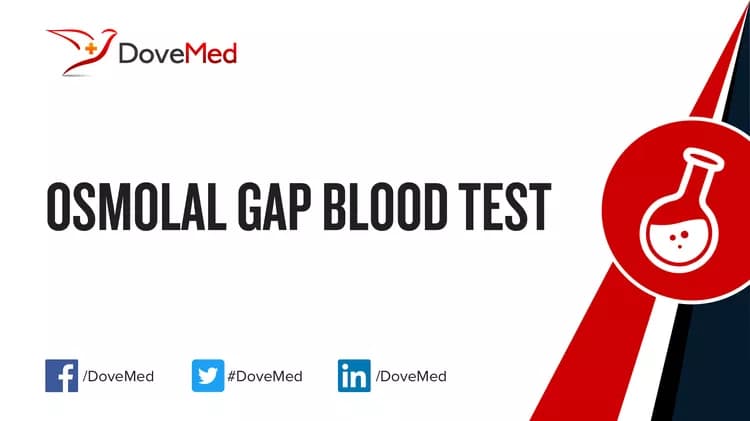What are other Names for this Test? (Equivalent Terms)
- OG Blood Test
What is Osmolal Gap Blood Test? (Background Information)
- Osmolality in blood testing refers to the number of dissolved chemicals in blood. Osmolality is reported in osmoles (Osm) per kilogram of blood
- Osmolality is similar to osmolarity, which measures the concentration of a compound in osmoles (Osm) per liter of total solution
- An osmole is a quantity of dissolved particles that contributes to the osmotic pressure of a solution. The greater the difference in osmolarity between two sides of a semipermeable membrane, the greater is the osmotic pressure
- Osmotic pressure causes a cell placed in salt water to shrink. This is because the higher osmolarity outside the cell relative to inside creates osmotic pressure directed towards the outside of the cell. Importantly, the cell’s membrane is semi-permeable. It allows water to pass but not other molecules that are charged, polar, or too large in size
- Solutes in the body include electrolytes and non-electrolytes, such as glucose
- Electrolytes are chemicals that dissociate in solution and conduct an electrical current. They are important to the body’s acid-base, electrical, and hydrostatic stability
- Electrolytes are mainly acquired through the diet. Major electrolytes include sodium (Na+), potassium (K+), chloride (Cl-), bicarbonate (HCO3-), and phosphate (HPO42-)
- Electrolytes are needed because they allow cells to regulate the flow of water across their membranes. This is called osmotic regulation. Osmotic regulation protects cells from bursting due to an influx of water, if their surroundings lack salt
- Osmolality is fine-tuned by the body through the use of hormones, such as anti-diuretic hormone (ADH), also known as vasopressin. ADH is produced by the hypothalamus of the brain and released by the pituitary gland
- When osmolality is measured, it is compared to an expected result that has been calculated. The difference is the osmotic gap. If the osmotic gap is too great, it may be indicative of toxins or diseases
- The Osmolal Gap Blood Test consists of subtracting the calculated osmolality from the measured osmolality. It is often performed to detect alcohol poisoning and kidney disease, and to determine the cause of diarrhea
What are the Clinical Indications for performing the Osmolal Gap Blood Test?
Following are the clinical indications for performing the Osmolal Gap Blood Test:
- Excessive thirst
- Altered mental status
- Headache
- Vision problems
- Fatigue
How is the Specimen Collected for Osmolal Gap Blood Test?
Following is the specimen collection process for Osmolal Gap Blood Test:
Sample required: Blood
Process of obtaining a blood sample in adults:
- A band is wrapped around the arm, 3-4 inches above the collection site (superficial vein that lies within the elbow pit)
- The site is cleaned with 70% alcohol in an outward spiral, away from the zone of needle insertion
- The needle cap is removed and is held in line with the vein, pulling the skin tight
- With a small and quick thrust, the vein is penetrated using the needle
- The required amount of blood sample is collected by pulling the plunger of the syringe out slowly
- The wrap band is removed, gauze is placed on the collection site, and the needle is removed
- The blood is immediately transferred into the blood container, which has the appropriate preservative/clot activator/anti-coagulant
- The syringe and the needle are disposed into the appropriate “sharp container” for safe and hygienic disposal
Preparation required: No special preparation is needed prior to the test.
What is the Significance of the Osmolal Gap Blood Test Result?
A high level (greater than 10 mOsm/kg) for the Osmolal Gap Blood Test may point to a diagnosis of the following conditions:
- Hyperlipidemia
- Hyperproteinemia
- Alcohol consumption
- Ingestion of the following compounds:
- Methanol
- Isopropyl alcohol
- Mannitol
The laboratory test results are NOT to be interpreted as results of a "stand-alone" test. The test results have to be interpreted after correlating with suitable clinical findings and additional supplemental tests/information. Your healthcare providers will explain the meaning of your tests results, based on the overall clinical scenario.
Additional and Relevant Useful Information:
- Certain factors interfere with the results of the Osmolal Gap Blood Test. These include hydration status, pregnancy, and consumption of electrolyte-rich foods
- Blood alcohol, in mg/dL, is calculated using the following formula: Osmolal gap x 100 / 22
Certain medications that you may be currently taking may influence the outcome of the test. Hence, it is important to inform your healthcare provider of the complete list of medications (including any herbal supplements) you are currently taking. This will help the healthcare provider interpret your test results more accurately and avoid unnecessary chances of a misdiagnosis.
The following DoveMed website link is a useful resource for additional information:
http://www.dovemed.com/common-procedures/procedures-laboratory/osmolality-urine-test/
Please visit our Laboratory Procedures Center for more physician-approved health information:
http://www.dovemed.com/common-procedures/procedures-laboratory/
Related Articles
Test Your Knowledge
Asked by users
Related Centers
Related Specialties
Related Physicians
Related Procedures
Related Resources
Join DoveHubs
and connect with fellow professionals


0 Comments
Please log in to post a comment.